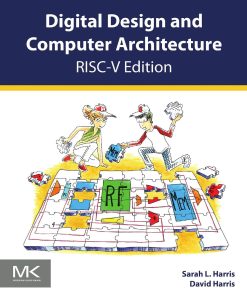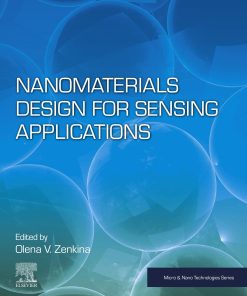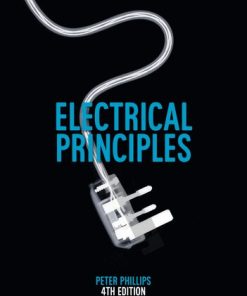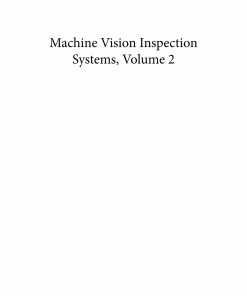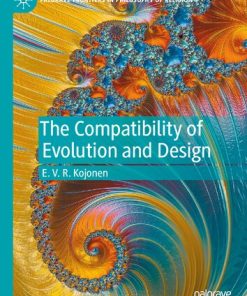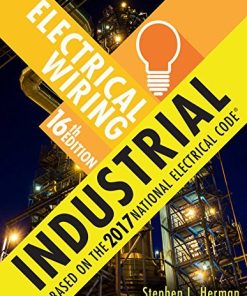(Ebook PDF) Electrical Machine Design 1st edition by Rajini, Nagarajan 9332585571 978-9332585577 full chapters
$50.00 Original price was: $50.00.$25.00Current price is: $25.00.
Electrical Machine Design 1st edition by V. Rajini, V. S. Nagarajan – Ebook PDF Instant Download/DeliveryISBN: 9332585571, 978-9332585577
Full dowload Electrical Machine Design 1st edition after payment.
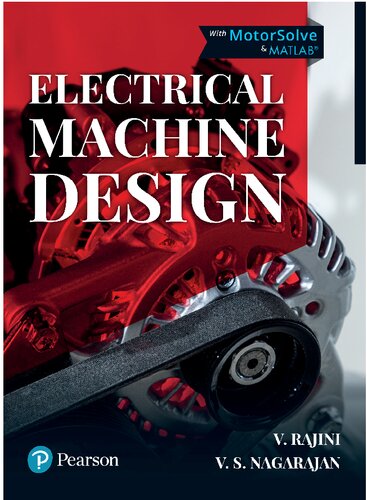
Product details:
ISBN-10 : 9332585571
ISBN-13 : 978-9332585577
Author: V. Rajini, V. S. Nagarajan
Brand New
Electrical Machine Design 1st Table of contents:
1. Basic Design Considerations of Electrical Machines
1.1 Principles of Design
1.2 Factors for Consideration
1.3 Classification of Design Problem
1.3.1 Need for Computer-aided Design
1.4 Specifications and Standards
1.5 Constraints of Design
1.6 Dimensions and Rating of Machines
1.7 Output Equation
1.7.1 DC Machine
1.7.2 AC Machine
1.8 Materials for Electrical Machines
1.8.1 Conducting Materials
1.8.2 Resistive Materials
1.8.3 Magnetic Materials
1.8.4 Insulation Materials
1.9 Heat Dissipation Modes
1.10 Types of Cooling (Ventilation)
1.10.1 Cooling of Turbo Alternators
1.11 Types of Enclosure
1.12 Quantity of Coolant
1.13 Types of Duties and Ratings
1.14 Determination of Temperature Rise and Fall
Review Questions
Multiple-choice Questions
Short Type Questions
Long Type Questions
Problems
2. Design of Magnetic Circuits
2.1 Introduction
2.1.1 Analysis of Series Composite Magnetic Circuit
2.1.2 Analysis of Parallel Composite Magnetic Circuits
2.1.3 Comparison Between Magnetic Circuit and Electric Circuit
2.2 Determination of Reluctance and MMF of Air Gap
2.2.1 Contraction of Air Gap Area Per Pole (Effective Air Gap Area)
2.2.2 Effect of Pole Saliency
2.3 Determination of MMF of Teeth
2.4 Real Flux Density and Apparent Flux Density
2.5 Iron Loss Calculation
2.5.1 Hysteresis Loss
2.5.2 Eddy Current Loss
2.5.3 Total Iron or Core Loss
2.5.4 Pulsation Loss
2.6 Magnetic Leakage
2.7 Estimation of Specific Permeance and Leakage Reactance
2.7.1 Parallel-sided Slot
2.7.2 Parallel-sided Slot with Double Layer Windings
2.7.3 Tapered Slot
2.7.4 Circular Slot
2.7.5 T Bar Slot (Induction Motor)
2.8 Magnetic Pull
2.8.1 Radial Magnetic Forces
2.8.2 Radial Magnetic Forces and Unbalanced Magnetic Pull
2.8.3 Determination of Unbalanced Magnetic Pull
2.8.4 Significance and Minimization of Unbalanced Magnetic Pull
Review Questions
Multiple-choice Questions
Short Type Questions
Long Type Questions
Problems
3. Design of Transformer
3.1 Introduction
3.1.1 Based on Voltage Ratio
3.1.2 Based on Construction
3.1.3 Based on Application
3.1.4 Based on Number of Phases
3.2 Specifications of a Transformer
3.3 Design of Transformer
3.3.1 Output Equation of Single-phase Transformer
3.3.2 Output Equation of Single-phase Transformer (Core-type)
3.3.3 Output Equation of Single-phase Transformer (Shell-type)
3.3.4 Output Equation of Three-phase Transformer
3.3.5 Output Equation of Three-phase Transformer (Core-type)
3.3.6 Output Equation of Three-phase Transformer (Shell-type)
3.4 Volt Per Turn of Winding
3.5 Choice of Flux Density
3.6 Choice of Current Density
3.7 Design of Core
3.7.1 Square Core
3.7.2 Stepped Core
3.8 Design of Yoke
3.9 Window and Core Proportions
3.10 Overall Dimensions
3.10.1 Single-phase Core-type Transformer
3.10.2 Three-phase Core-type Transformer
3.10.3 Single-phase Shell-type Transformer
3.10.4 Three-phase Shell-type Transformer
3.11 Design of Windings
3.11.1 Type and Choice of Windings
3.12 Resistance Calculation
3.13 Reactance Calculation
3.13.1 Leakage Reactance of a Core-type Transformer with Concentric LV and HV Coils of Equal Height or Length
3.14 Flowchart for Overall Design of Transformer
3.15 No Load Current of a Transformer
3.15.1 Single-phase Transformer
3.15.2 Three-phase Transformer
3.15.3 Magnetizing Volt – Ampere and Alternate Expression for Magnetizing Current
3.16 Transformer Losses
3.17 Effects of Change in Frequency in Parameters of the Transformer
3.18 Optimum Design
3.19 Cooling of Transformer
3.20 Temperature Rise and Design of Cooling System
3.21 Temperature Rise in Plain-walled Tank
3.22 Temperature Rise in Tank with Tubes
3.23 Design of Tank with Tubes
3.23.1 Flow Chart for Design of Cooling System
3.24 Mechanical Forces
3.25 Computer-aided Design of Transformer
Review Questions
Multiple-choice Questions
Short Type Questions
Long Type Questions
Problems
4. Design of Three-phase Induction Motor
4.1 Introduction
4.2 Construction
4.3 Specifications
4.4 Output Equation of 3ϕ Induction Motor
4.5 Choice of Specific Loadings
4.5.1 Choice of Specific Magnetic Loading,‘Bav’
4.5.2 Choice of Specific Electric Loading, ‘ac’
4.6 Calculation of Main Dimensions (Separation of D and L)
4.7 Design of Stator of Three-phase Induction Motor
4.8 Calculation of Length of Air Gap
4.9 Design of Rotor of 3ϕ Induction Motor
4.9.1 Design of Squirrel Cage Rotor
4.9.2 Design of Wound or Slip-ring Rotor
4.10 Estimation of Operating Characteristics
4.10.1 Core Loss Component
4.10.2 Magnetizing Component
4.11 Harmonic Torques
4.11.1 Loss Component
4.12 Short Circuit Current
4.12.1 Stator Resistance
4.12.2 Rotor Resistance
4.13 Circle Diagram
4.14 Dispersion Coefficient
4.15 Computer-aided Design of Three-phase Induction Motor
Review Questions
Multiple-choice Questions
Short Type Questions
Long Type Questions
Problems
5. Design of Single-phase Induction Motor
5.1 Introduction
5.2 Construction
5.2.1 Split Phase Motors
5.2.2 Shaded Pole Motors
5.2.3 Repulsion Motors
5.3 Design Considerations
5.4 Specifications
5.5 Constructional Features
5.6 Design of Single-phase Induction Motor
5.6.1 Output Equation
5.6.2 Choice of Specific Loadings
5.6.3 Separation of D and L
5.6.4 Design of Stator
5.6.5 Design of Rotor
5.6.6 Magnetic Circuit Calculations
5.6.7 Calculation of Resistance and Leakage Reactance
5.7 Performance Calculation
5.7.1 Equivalent Circuit Method
5.7.2 Analytical Method (Veinott’s Method)
Review Questions
Short Type Questions
Long Type Questions
6. Design of Synchronous Machine
6.1 Introduction
6.2 Types of Synchronous Machine
6.2.1 Types of Synchronous Generators
6.3 Constructional Aspects of Synchronous Machines
6.4 Construction of Hydro Generators
6.5 Construction of Turbo Generator
6.6 Synchronous Motor
6.7 Specifications
6.8 Output Equation
6.9 Choice of Specific Loadings
6.9.1 Choice of Bav (Specific Magnetic Loading)
6.9.2 Choice of ac (Specific Electric Loading)
6.10 Design of Salient Pole Machine
6.10.1 Main Dimensions
6.10.2 Types of Poles
6.11 Design of Turbo Generator
6.12 Computer-aided Design of Three-phase Synchronous Machine
Review Questions
Multiple-choice Questions
Short Type Questions
Long Type Questions
Problems
7. DC Machine
7.1 Introduction
7.2 Construction
7.2.1 Field or Excitation System
7.2.2 Rotor
7.2.3 Specifications of DC Machine
7.3 Output Equation
7.3.1 Estimation of Power, Pa
7.4 Choice of Specific Loadings of DC Machine
7.4.1 Choice of Specific Magnetic Loading (Bav)
7.4.2 Choice of Specific Electric Loading (ac)
7.5 Choice of Number of Poles
7.5.1 Guidelines for the Selection of Poles
7.6 Limitations of D and L
7.6.1 Limiting Values of Core Length (L)
7.6.2 Limiting Value of Armature Diameter (D)
7.7 Separation of D and L
7.8 Estimation of Length of Air Gap
7.8.1 Factors Affecting Air Gap Length
7.8.2 Estimation of lg
7.9 Design of Armature
7.10 Design of Commutator and Brushes
7.10.1 Brush Dimensions
7.10.2 Commutator Losses and Temperature Rise
7.11 Design of Field System of DC Machine
7.11.1 Design of Pole
7.11.2 Design of Shunt Field Winding
7.11.3 Design of Series Field Winding
7.12 Design of Interpoles
7.13 Computer-aided Design of DC Machine
Review Questions
Multiple-choice Questions
Short Type Questions
Long Type Questions
Problems
8. Computer-aided Design and Analysis of Electric Motors
8.1 Introduction
8.2 Salient Pole Synchronous Motor
8.3 Induction Motor
8.4 Separately Excited DC Motor
People also search for Electrical Machine Design 1st:
electrical machinery and equipment
electrical machine repair
electrical machines book
electrical machine screws
electrical machine repair near me
You may also like…
Young and Teens
Engineering - Electrical & Electronic Engineering
Politics & Philosophy
Uncategorized



